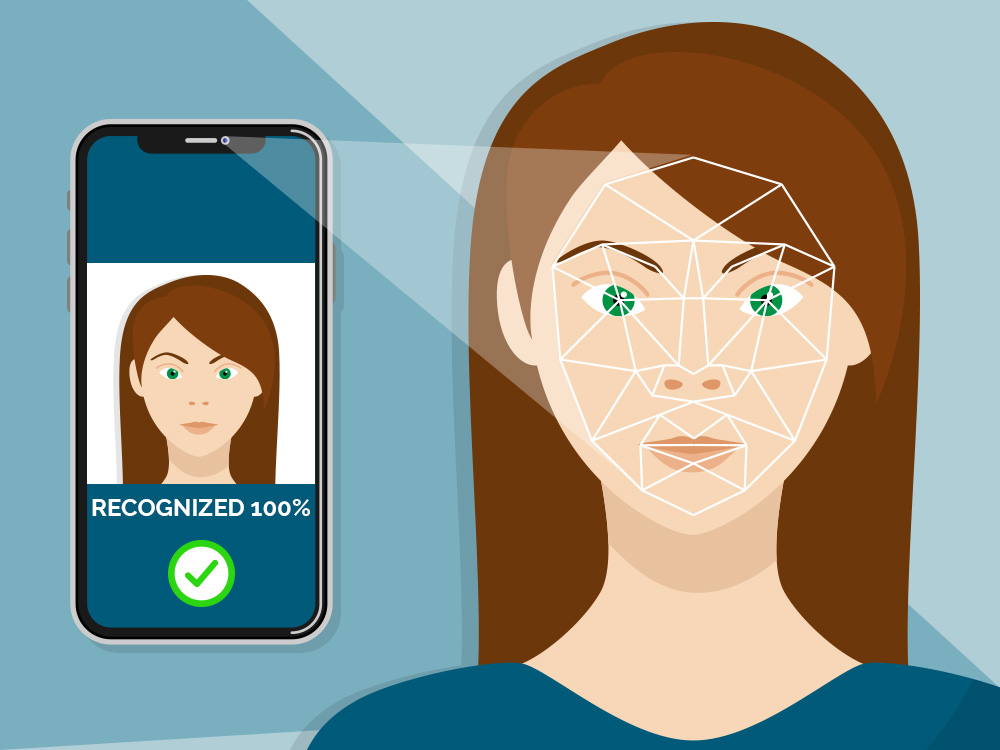Facial recognition software, once a figment of Sci-Fi imagination, has recently become an accessible, viable tool for common smartphone use. The image of a person passing a high-clearance checkpoint by scanning his or her handprint, face or eyes, emerged in public imagination throughout the 20th Century – passed down through franchises such as Star Trek and X-Men, and films like Stanley Kubrick’s 2001: A Space Odyssey. In the 21st Century, now two decades old, contemporary technology has brought facial recognition security into fruition.

Biometrics and Facial Recognition Software, By the Financial Figures
Companies, in collaboration with a software designer, can now create mobile applications with facial recognition software. The biometrics industry, the official umbrella under which commercial facial recognition software falls, constitutes a profitable, forwardly momentous sector of current mobile technology.
A study published in June 2019 estimates that by 2024, the global facial recognition software market would generate $7 billion of revenue, supported by a compound annual growth rate (CAGR) of 16% over the period 2019-2024. For 2019, the market is estimated at $3.2 billion.
The two most significant drivers of this growth are surveillance in the public sector and numerous other applications in diverse market segments, powered by the ubiquity of the smartphone.
Common Security Applications of Smartphone and Digital Facial Recognition
Biometrics has boomed in recent years due to some of its practical applications in security and crime surveillance technology. With video cameras all over drones and street corners, as well as in your pocket, the need for biometric security features has increased. Both government and private companies are now using digital surveillance through biometric technology on massive scales, such as in Hong Kong or Portland and Louisville during recent protests. By recording movement in public and preventing theft, biometric technology performs a practical security purpose.
The most secure way to authenticate identity is not with a password, but with the biological signature of the person themselves. Anyone can enter a password. Hackers can comb through the databases of low-security websites for information like passwords. But copying someone’s actual fingerprint or face poses a more significant security barrier, even if you have a photograph. Through facial recognition authentication, you can increase the security of your system’s accounts thoroughly and immediately. A smartphone carries a camera, and very often a thumbprint scanner.
Why Should Hire Mobile App Developers For Your Business
Which Sorts of Apps Might Benefit from Using Facial Recognition Software?
With this hardware, an app can open or perform tasks through facial recognition software. In theory, you could add a facial scanning feature to any sort of mobile or even web application. Security clearance does not necessarily affect any other functionalities within your app. However, doing so requires an investment of time and capital. And unless you have an in-house software expert, you will also need to add this feature to your app via the help of a custom app developer.
Some apps won’t see a significant improvement by integrating greater security measures, so in those cases, you would not need to invest in facial recognition. If you’re producing a mobile gaming app, for example, or a fashion blog, chances are your app doesn’t trade in highly sensitive personal information. By adding fancy clearance software, you may essentially be wasting your money to make logging into your app more complicated for users.
However, businesses in industries vulnerable to data breaches can benefit greatly from facial recognition. The context and goals of your business and mobile app will guide your decision in whether or not to add a sophisticated feature to your app’s security.
Protecting Your Clients’ Sensitive Financial Data
If your business is a bank, private information entered on your mobile and web apps are among the most sensitive. To create a bank account, you usually need a social security number as well as a menu of personal data to set up and access this account. You must input Date of Birth (DOB), phone numbers, passwords for emails, driver’s license numbers, personal security questions, et cetera, in order to create this account. All of this information then becomes housed on the server of the mobile app. And mobile applications, accessible from almost anywhere, can become an easy way into your server for hackers with VPN’s.
E-Commerce sites often need the input of credit card numbers, which directly link to your bank accounts. The information gleaned from low-security E-Commerce sites can let hackers impersonate your identity or even start making unauthorized debit or credit card purchases.
If you take into account other real-world complications, such as having a child or children in your household, the need for security rises. You may accidentally leave your smartphone on the table and go to another room, or even leave your house, in which case your kid could pick up your phone and start playing with it. In a worst-case scenario, your child makes purchases on an E-Commerce platform that auto-remembers your credit card information. Nightmare scenarios happen –
“Toddler buys car using dad’s smartphone.”
An errant toddler hand can unknowingly erase important data. Let’s say you have an app for Blue Cross, or another health insurance website. By typing randomly on your phone, your child could delete health records or requests for medication, leading you into a health-threatening fiasco.
For mobile apps trading in precarious health, financial, and identification information, having facial recognition software can provide both data security and an easing of anxiety for your clients. Thankfully, facial recognition is an actual possibility in the current field of mobile app technology. With the proliferation of data breaches and large scale hacks, you may find it worth it to keep your and your clients’ personal information safe through the simple addition of custom software.

